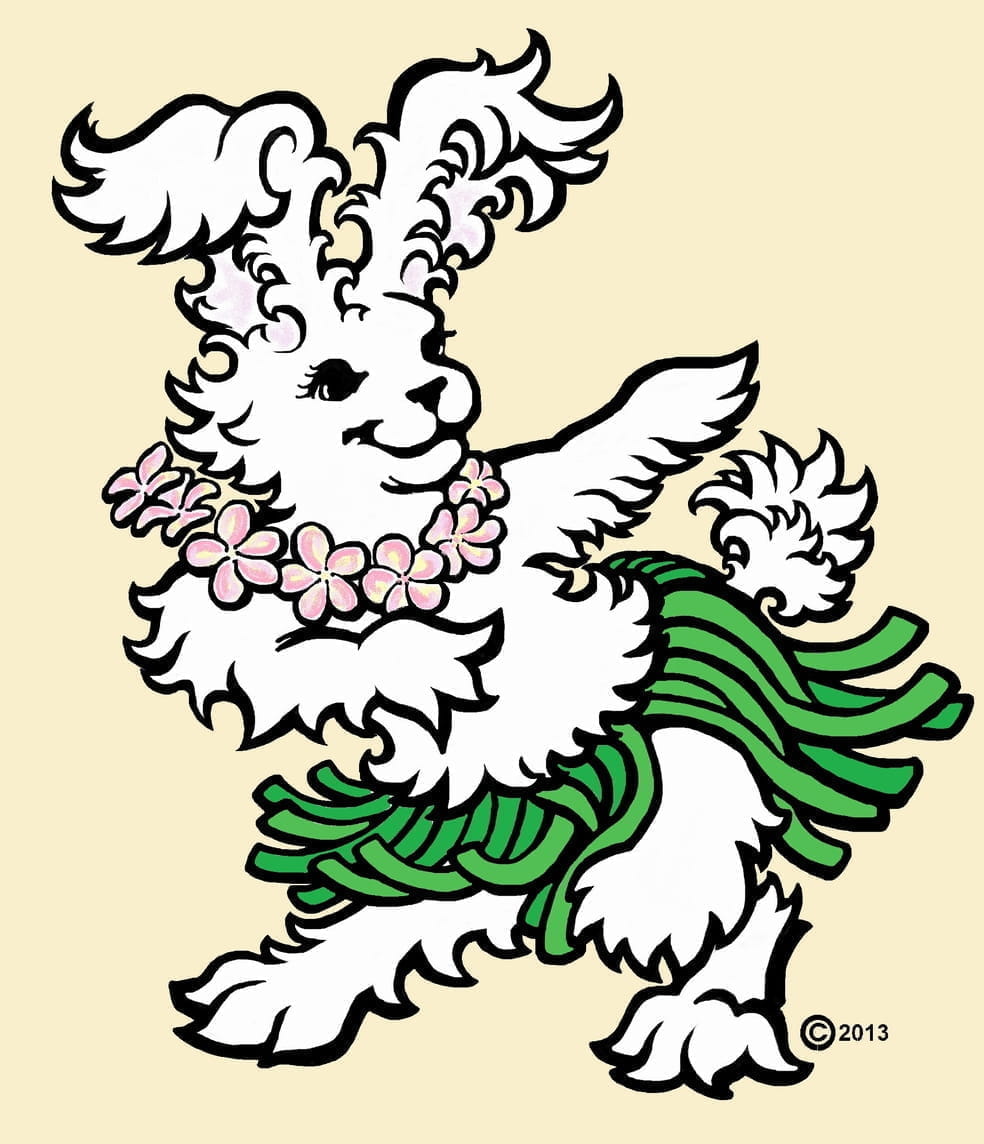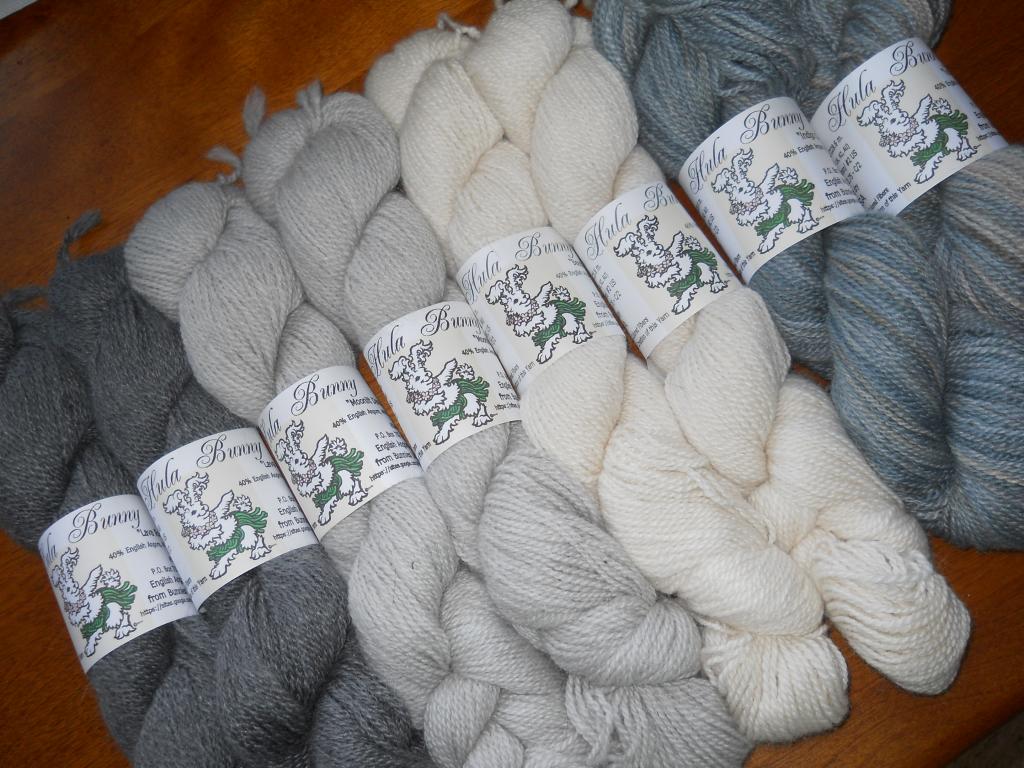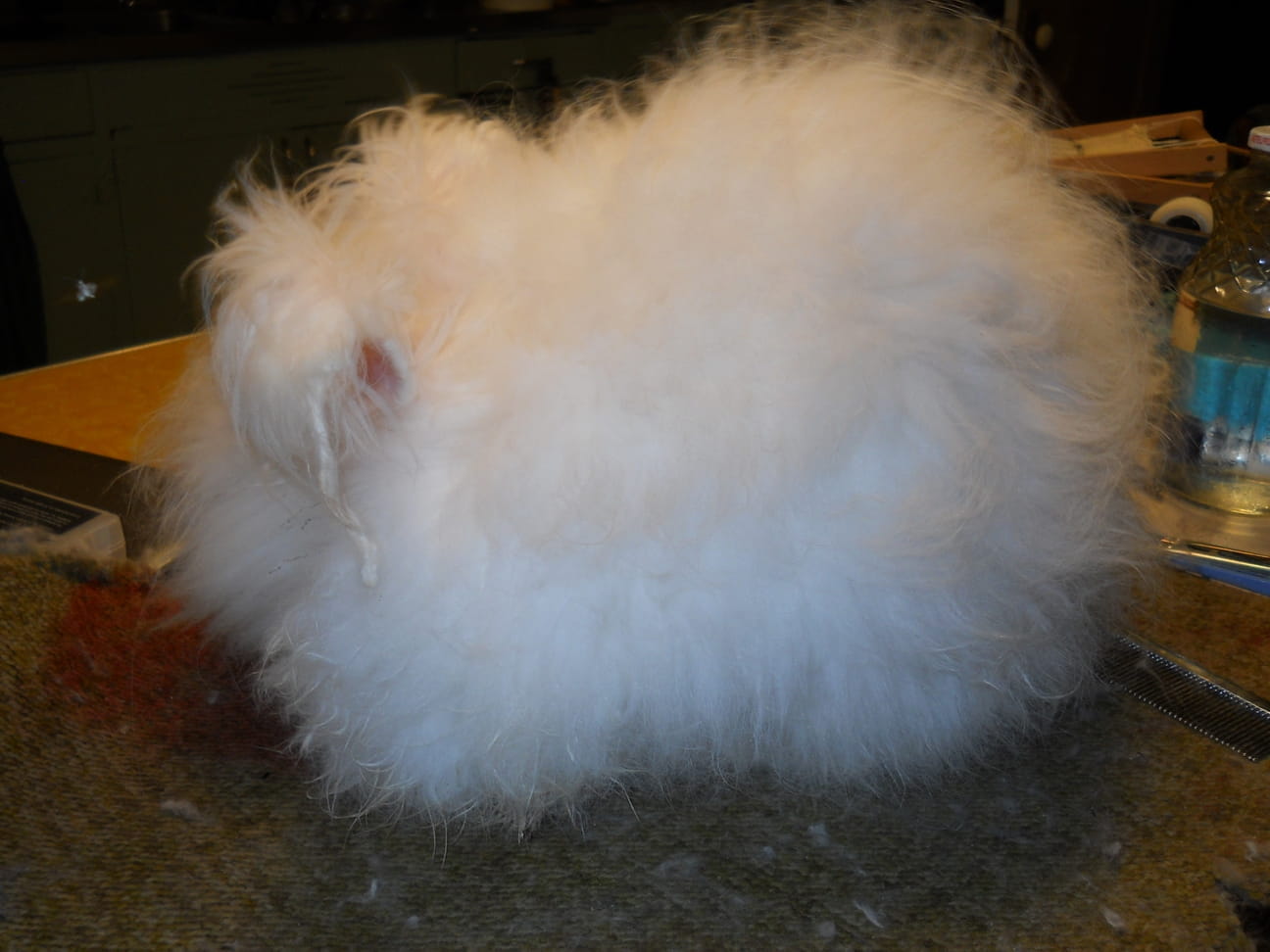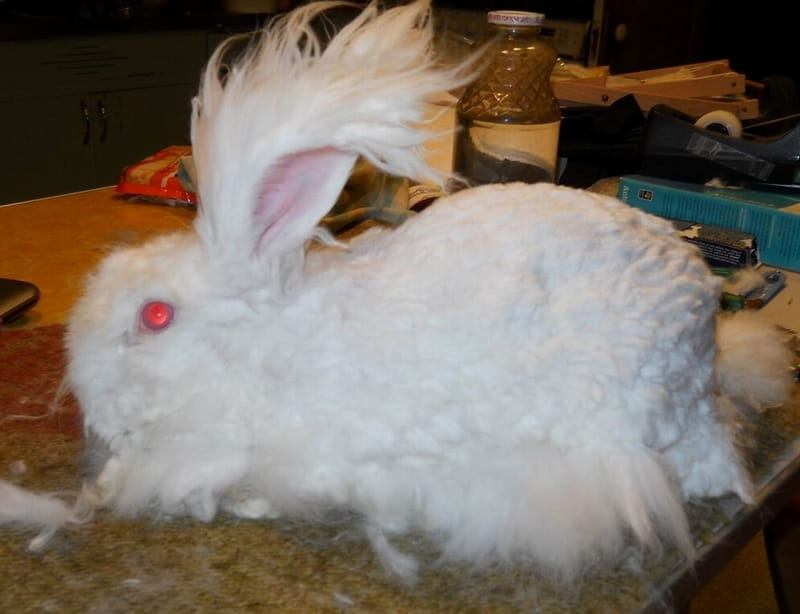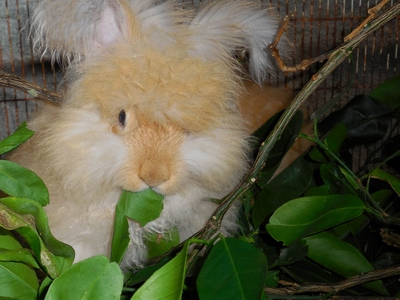The bunnies here at Hillside Farm Hawaii mostly provide fiber for two different types of yarns. The majority of the yarn made with their bunny fluff is Hillside Farm's 'Hula Bunny Yarn'. Hula Bunny Yarn is a commercially spun yarn made of our bunny fluff mixed with very fine Merino sheep's wool and also silk. The bunny fluff is to give it an incredible softness, the Merino provides stretch and bounce, the silk adds a touch of shine. All these fibers are blended together and spun to a fingering weight of yarn. It is then put up in to skeins and labeled with the Hula Bunny label. It's exquisitely soft with just a hint of shine and a bit of elasticity, although not too much. Great for scarves and shawls or places where you want insanely soft yarns. (Or, in the words of our rustic feed store guy - who looks like an old crusty cowboy who was rode hard and put away wet - "Hey! This'd be great for men's underwear!" We haven't tried it yet, but if you do, let us know how it turns out.)
Hula Bunny yarn logo
The logo still isn't officially finished even though we've been using it on the yarn labels now for years. Eventually, the words 'Hula Bunny Yarn' is supposed to go over the top in sort of an arch. Below the logo should be the motto "trying to make the best yarn in the universe - one bunny at a time". Which is kinda long motto, I suppose. Maybe it's our 'mission statement"? We're just bunnies in a backyard after all. Maybe it will get finished someday although it's not even on the 'to do' list at the moment.
Hula Bunny Yarns
The yarns in the picture are all Hula Bunny yarns, although we don't always have that many colors of them. Starting from the left, we have the dark gray 'Lava Rocks' color of Hula Bunny yarn. It's made with bunny fluff from the black bunnies as well as black Merino sheep's wool. The next silvery gray yarn is Hula Bunny's 'Moonlit Dance' color of yarn, which is one of our three more or less 'standard' colors. It's also made from the fiber from the black bunnies although it has white Merino and silk added to it. The only color comes from the bunnies. Since a bunny only has a certain amount of color for each hair they grow, as the hair gets longer the color fades. Which means black bunnies become this lovely silvery gray when it's time to harvest their wool. So the first two skeins are made with fiber from our black bunnies.
The next creamy white skein is made with the fiber from our white albino bunnies. The color is called 'Coconut Dream' and since we're down to only two white rabbits at this time, we are going to be short on this color until we get more white bunnies. It is supposed to be one of the three 'standard' colors, but we need more white bunnies. The last skein which is a varigated blue color is some of the sandy - tawny 'Beach Bunny' color of Hula Bunny yarn that has been over dyed with local indigo. We don't have that color very often at all, mostly because it's an additional step to gather the indigo and dye the yarn.
Hula Bunny yarn's 'Beach Bunny' color
(the camera flash washed out the color on the middle two skeins)
The third 'standard' color of Hula Bunny yarn that we have is our 'Beach Bunny' color. It is a nice warm sandy color of yarn made from the tortoiseshell and fawn colors of bunnies along with the white Merino and silk.
The three 'standard' colors are the sandy 'Beach Bunny', the silvery 'Moonlit Dance' and the creamy white 'Coconut Dream'. Those three colors are made with only the color from the bunny fluff creating the color of the yarns.
Following those three colors, the next most likely variety will be the darker gray 'Lava Rocks' color. That's the silvery gray fiber from our black bunnies with the black Merino sheep's wool. We occasionally have the various colors of indigo blue, although they aren't going to be very closely matching colors at all, mostly since I'm not a very exact dyer. And not very often there will be any other commercial dye colors because we generally don't get around to dyeing yarn very often.
Hula Bunny yarn is 40% English angora fluff from the bunnies here at Hillside Farm Hawaii. Added to that is 40% fine Merino sheep's wool for bounce and stretch. Then 20% Tussah silk is added for shine and strength. All spun up usually as a two ply yarn, although once we did have a batch spun as a three ply which did make it a more 'round' yarn, but didn't seem to encourage the fluffiness factor as much. The first batch of Hula Bunny yarn was in 2012 or 2013, I forget exactly when, although I suppose I could go look it up. There's been four batches of Hula Bunny yarn so far and we're preparing the fibers (as of March, 2023) to send off for the latest batch. It takes several months from the time the fibers are sent off until the yarn comes back.
Currently, (as of June 2023), our usual mill is moving to a new farm so they're not taking in any more yarn orders until they get moved. There may or may not be a local fiber mill (WOOT!) but at this time, that's just a rumor and rumor has it that the mill won't be set up and functional for several years. (Sigh!)
It also takes a mill several months or more to get the fiber spun into yarn and sent back. Many of them have a one year waiting list. I may have to spin up some "Hillside Farm Yarn", but that isn't as even or fine as the millspun. I suppose practice will improve things.
Handspun 100% English angora 'Hillside Farm' yarn
The other type of yarn the bunnies provide fiber for is our 'Hillside Farm' yarn. This is a handspun 100% English angora yarn. Since I'm the one spinning it and I'm not the most consistent spinner, it doesn't always come in one specific weight (thickness) of yarn, although usually it's around worsted weight. But we occasionally see bulky weight, it's very rarely fingering or thinner. It comes in different lengths and no telling if there will ever be any more that matches it from one skein to the next. There also isn't very much of it, since more of my time these days is taken up with taking care of bunnies so there's not much time to spin as there was before.
The handspun pure angora is a lovely yarn, though. It's got more 'halo' and is even softer than Hula Bunny yarn. But, it's not consistent.

Handspun 100% English angora Hillside Farm yarn scarf
The handspun 'Hillside Farm' yarns are usually a much bulkier yarn than the commercially spun Hula Bunny. I also don't mind a slub here or there since if it's gonna be hand spun, why try to make it look like it's a commercial yarn? Hillside Farm English Angora yarns generally knit up into a thicker item than the thinner Hula Bunny yarn. The Hillside Farm yarn is usually 100% English angora so it has zero stretch to it. Knitting or crocheting something that drapes is a good choice for pure 100% English angora yarn. Since the English angoras don't have as many guard hairs as the French, Satin, German or Giant angoras, the 'halo' on the yarn is much softer and not as spikey as one usually sees on commercial angora yarns. Hula Bunny yarns also have the same softer halo since they only hae English angora and not other types of angora fibers.
For most of the yarn from Hillside Farm, the color of the yarn comes from the color of the bunnies. With the Hula Bunny yarns, the Merino and silk that are added are white, with the exception of our 'Lava Rocks' color of Hula Bunny yarn. That has black Merino added instead of white. There is also the occasional batch of Hula Bunny yarn which will be dyed. Either with locally grown indigo (it's a roadside weed, actually, nobody specifically grows the stuff) or sometimes the yarn is dyed with commercial dyes. At some point I'll put in a page about dyeing yarn with indigo, it's a pretty easy process and absolutely sustainable - but back to the colors of Hula Bunny yarns. Since the Hula Bunny yarn colors come from the bunnies, we can sort your fiber providers according to which color of yarn you're knitting with so you will know which bunny helped make the yarn.

